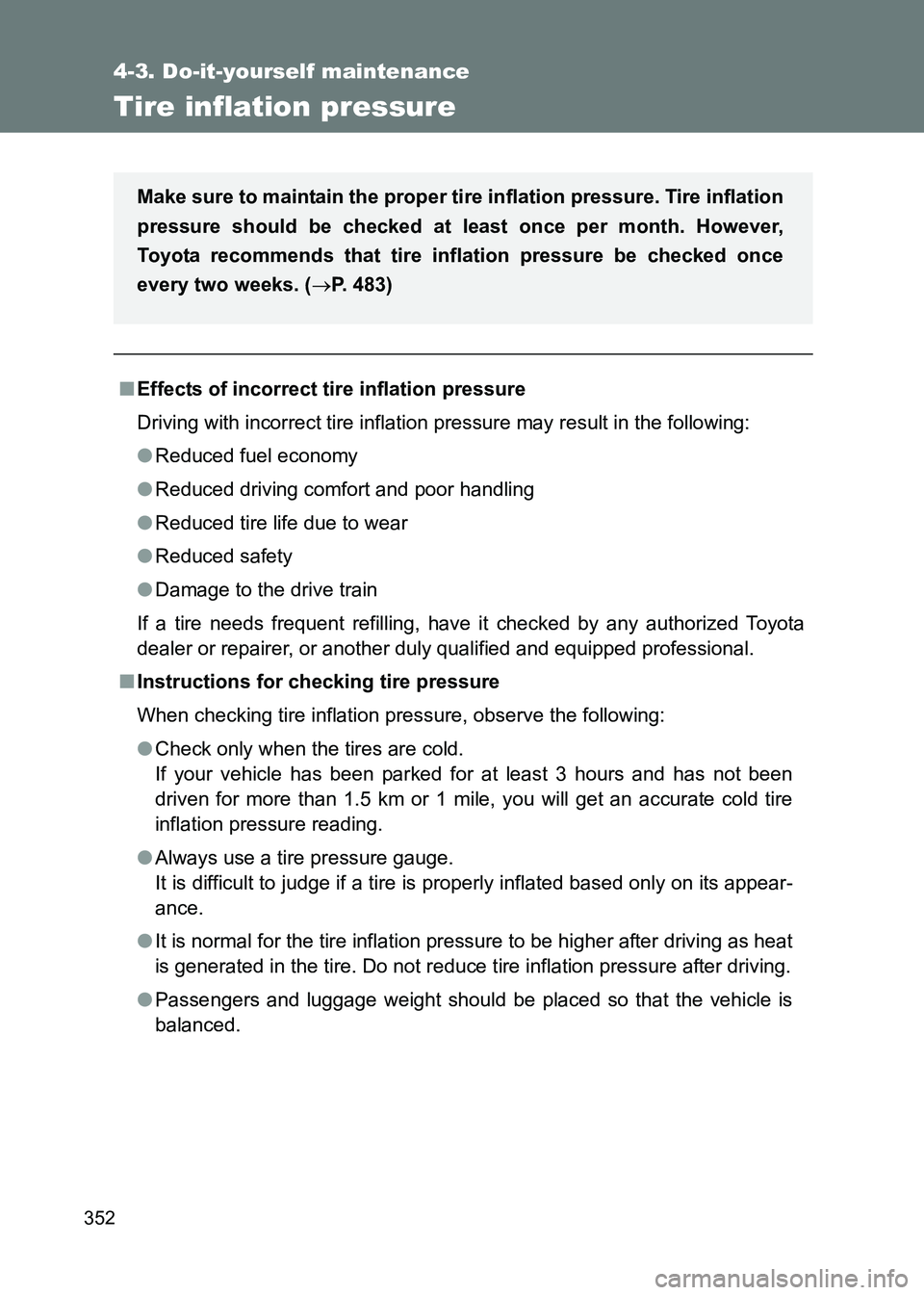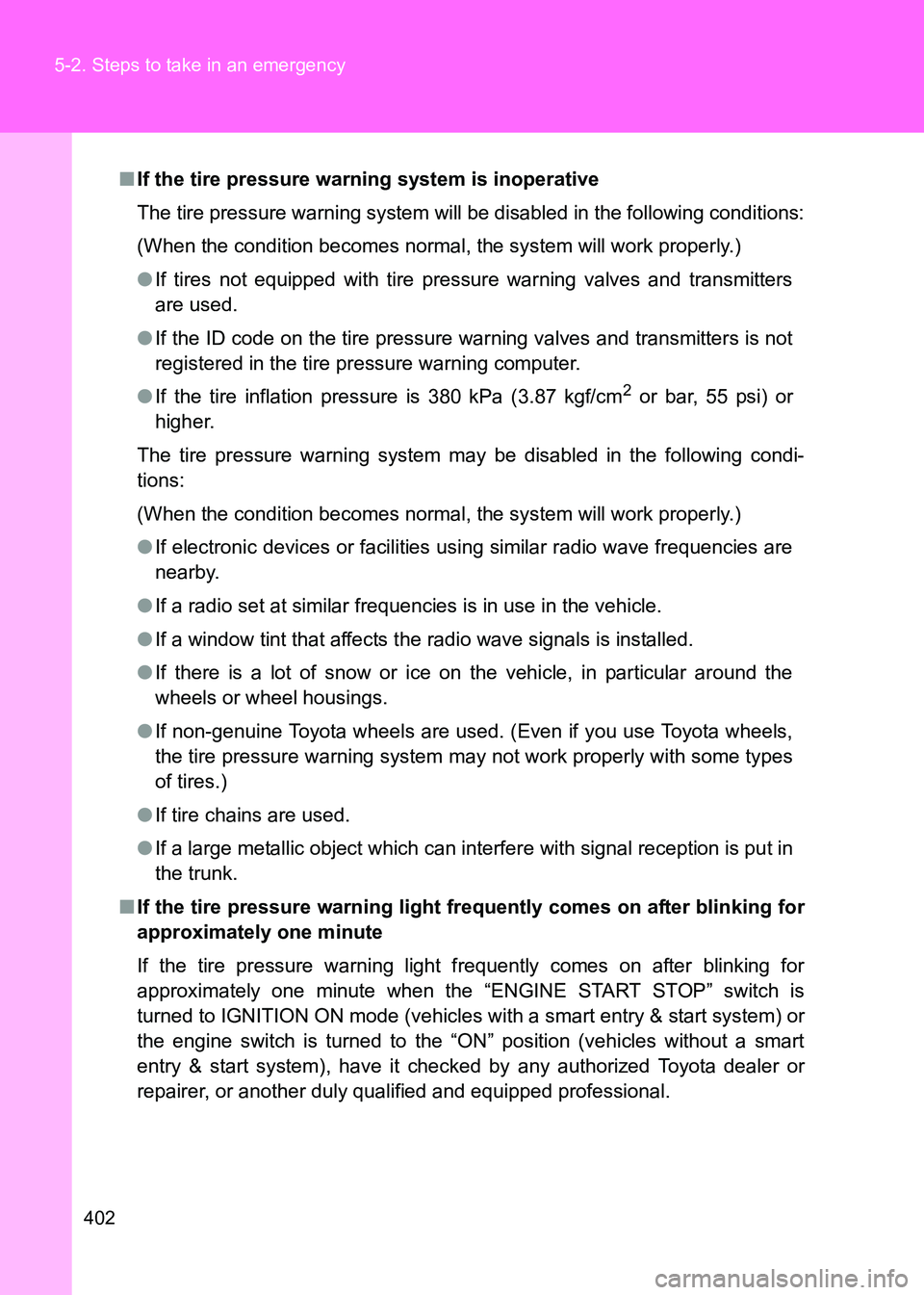Page 349 of 505

349
4-3. Do-it-yourself maintenance
4
Maintenance and care
86_EE (OM18071E)
WARNING
■
Tire pressure warning system operation
The tire pressure warning system may not provide warning immediately if a
tire bursts or if sudden air leakage occurs.
■ When inspecting or replacing tires
Observe the following precautions to prevent accidents.
Failure to do so may cause damage to parts of the drive train, as well as
dangerous handling characteristics, which may lead to an accident resulting
in death or serious injury.
●Make sure to install 4 tires that are of the specified size, and that all 4 tires
are the same size, same maker, same brand and tread pattern.
● Do not use tire sizes other than those recommended by Toyota.
● Only use radial tires.
● Do not mix summer, all season and snow tires.
● Do not use tires that have been used on another vehicle.
Do not use tires if you do not know how they were used previously.
■ When initializing the tire pressure warning system
Do not operate the tire pressure warning reset switch without first adjusting
the tire inflation pressure to the specified level. Otherwise, the tire pressure
warning light may not come on even if the tire inflation pressure is low, or it
may come on when the tire inflation pressure is actually normal.
Page 351 of 505
351
4-3. Do-it-yourself maintenance
4
Maintenance and care
86_EE (OM18071E)
NOTICE
■
Low profile tires and wheels (vehicles with 17-inch tires)
Low profile tires may cause greater damage than usual to the tire wheel
when receiving impact from the road surface. Therefore pay attention to the
following:
●Be sure to use proper tire inflation pressure. If tires are under-inflated, they
may be damaged more severely.
● Avoid pot holes, uneven pavement, curbs and other road hazards. Failure
to do so can lead to severe tire and wheel damage.
■ If tire pressures become low while driving
Do not continue driving, or your tires and/or wheels may be ruined.
Page 352 of 505

352
4-3. Do-it-yourself maintenance
86_EE (OM18071E)
Tire inflation pressure
■Effects of incorrect tire inflation pressure
Driving with incorrect tire inflation pressure may result in the following:
● Reduced fuel economy
● Reduced driving comfort and poor handling
● Reduced tire life due to wear
● Reduced safety
● Damage to the drive train
If a tire needs frequent refilling, have it checked by any authorized Toyota
dealer or repairer, or another duly qualified and equipped professional.
■ Instructions for checking tire pressure
When checking tire inflation pressure, observe the following:
●Check only when the tires are cold.
If your vehicle has been parked for at least 3 hours and has not been
driven for more than 1.5 km or 1 mile, you will get an accurate cold tire
inflation pressure reading.
● Always use a tire pressure gauge.
It is difficult to judge if a tire is properly inflated based only on its appear-
ance.
● It is normal for the tire inflation pressure to be higher after driving as heat
is generated in the tire. Do not reduce tire inflation pressure after driving.
● Passengers and luggage weight should be placed so that the vehicle is
balanced.
Make sure to maintain the proper ti
re inflation pressure. Tire inflation
pressure should be checked at least once per month. However,
Toyota recommends that tire inflation pressure be checked once
every two weeks. ( →P. 483)
Page 353 of 505
353
4-3. Do-it-yourself maintenance
4
Maintenance and care
86_EE (OM18071E)
WARNING
■
Proper inflation is critical to save tire performance
Keep your tires properly inflated.
If the tires are not properly inflated, the following conditions may occur which
could lead to an accident resulting in death or serious injury:
●Excessive wear
● Uneven wear
● Poor handling
● Possibility of blowouts resulting from overheated tires
● Air leaking from between tire and wheel
● Wheel deformation and/or tire damage
● Greater possibility of tire damage while driving (due to road hazards,
expansion joints, sharp edges in the road, etc.)
NOTICE
■When inspecting and adjusting tire pressure
Be sure to reinstall the tire valve caps.
If a valve cap is not installed, dirt or moisture may get into the valve and
cause an air leak, resulting in decreased tire inflation pressure.
Page 355 of 505

355
4-3. Do-it-yourself maintenance
4
Maintenance and care
86_EE (OM18071E)
■
When replacing wheels
The wheels of your Toyota are equipped with tire pressure warning valves
and transmitters that allow the tire pressure warning system to provide
advance warning in the event of a loss in tire inflation pressure. Whenever
wheels are replaced, the tire pressure warning valves and transmitters must
be installed. ( →P. 343)
WARNING
■When replacing wheels
●Do not use wheels that are a different size from those recommended in the
Owner’s Manual, as this may result in loss of handling control.
● Never use an inner tube in a leaking wheel which is designed for a tube-
less tire. Doing so may result in an accident, causing death or serious
injury.
■ When installing the wheel nuts
●Never use oil or grease on the wheel bolts or wheel nuts.
Oil and grease may cause the wheel nuts to be excessively tightened,
leading to bolt or disc wheel damage. In addition, the oil or grease can
cause the wheel nuts to loosen and the wheel may fall off, causing an acci-
dent and resulting in death or serious injury. Remove any oil or grease
from the wheel bolts or wheel nuts.
● Be sure to install the wheel nuts with
the tapered ends facing inward. Install-
ing the nuts with the tapered ends fac-
ing outward can cause the wheel to
break and eventually cause the wheel
to come off while driving, which could
lead to an accident resulting in death or
serious injury.
Tapered portion
Page 400 of 505

400
5-2. Steps to take in an emergency
86_EE (OM18071E)
Tire pressure warning
light
When the light comes on:
Low tire inflation pressure
such as
• Natural causes (
→P. 401)
• Flat tire ( →P. 422, 438) Adjust the tire inflation pres-
sure (including the spare
tire) to the specified level.
The light will turn off after a
few minutes. In case the
light does not turn off even
if the tire inflation pressure
is adjusted, have the sys-
tem checked by any autho-
rized Toyota dealer or
repairer, or another duly
qualified and equipped pro-
fessional.
When the light comes on
after blinking for 1 minute:
Malfunction in the tire pres-
sure warning system
( → P. 402) Have the system checked by
any authorized Toyota
dealer or repairer, or another
duly qualified and equipped
professional.
Automatic transmission
fluid temperature warning
light (if equipped) Indicates that the auto-
matic transmission fluid
temperature is too high. Stop the vehicle in a safe
place and shift the shift lever
to P.
If the light goes off after a lit-
tle while, the vehicle can be
driven. If the light does not
go off, contact any autho-
rized Toyota dealer or
repairer, or another duly
qualified and equipped pro-
fessional.
Master warning light (if
equipped) A buzzer sounds and the
warning light comes on and
flashes to indicate that the
master warning system has
detected a malfunction. →
P. 404
Warning lightWarning light/DetailsCorrection procedure
Page 401 of 505

5
401
5-2. Steps to take in an emergency
When trouble arises
86_EE (OM18071E)
*: Driver's and front passenger’s seat belt buzzer:
The driver’s and front passenger’s seat belt buzzer sounds to alert the driver
and front passenger that his or her s eat belt is not fastened. The buzzer
sounds for 30 seconds after the vehicle has reached a speed of at least 20
km/h (12 mph). Then, if the seat belt is still unfastened, the buzzer will sound
in a different tone for 90 more seconds.
■ Front passenger detection sensor and passenger seat belt reminder
and warning buzzer
●If luggage is placed on the front passenger seat, the front passenger
detection sensor may cause the warning light to flash and warning
buzzer to sound, even if a passenger is not sitting in the seat.
● If a cushion is placed on the seat, the sensor may not detect a passen-
ger, and the warning light may not operate properly.
■ When the tire pressure warning light comes on
Check the tire inflation pressure and adjust to the appropriate level. Pushing
the tire pressure warning reset switch will not turn off the tire pressure warn-
ing light.
■ The tire pressure warning light may turn on due to natural causes
The tire pressure warning light may turn on due to natural causes such as
natural air leaks or tire inflation pressure changes caused by temperature. In
this case, adjusting the tire inflation pressure will turn off the warning light
(after a few minutes).
Page 402 of 505

402
5-2. Steps to take in an emergency
86_EE (OM18071E)
■
If the tire pressure warning system is inoperative
The tire pressure warning system will be disabled in the following conditions:
(When the condition becomes normal, the system will work properly.)
● If tires not equipped with tire pressure warning valves and transmitters
are used.
● If the ID code on the tire pressure warning valves and transmitters is not
registered in the tire pressure warning computer.
● If the tire inflation pressure is 380 kPa (3.87 kgf/cm
2 or bar, 55 psi) or
higher.
The tire pressure warning system may be disabled in the following condi-
tions:
(When the condition becomes normal, the system will work properly.)
● If electronic devices or facilities using similar radio wave frequencies are
nearby.
● If a radio set at similar frequencies is in use in the vehicle.
● If a window tint that affects t he radio wave signals is installed.
● If there is a lot of snow or ice on the vehicle, in particular around the
wheels or wheel housings.
● If non-genuine Toyota wheels are used. (Even if you use Toyota wheels,
the tire pressure warning system may not work properly with some types
of tires.)
● If tire chains are used.
● If a large metallic object which can interfere with signal reception is put in
the trunk.
■ If the tire pressure warning light frequently comes on after blinking for
approximately one minute
If the tire pressure warning light frequently comes on after blinking for
approximately one minute when the “ENGINE START STOP” switch is
turned to IGNITION ON mode (vehicles with a smart entry & start system) or
the engine switch is turned to the “ON” position (vehicles without a smart
entry & start system), have it checked by any authorized Toyota dealer or
repairer, or another duly qualified and equipped professional.